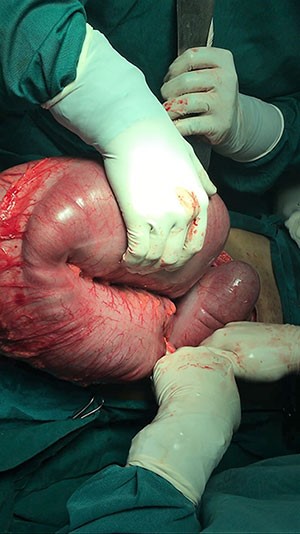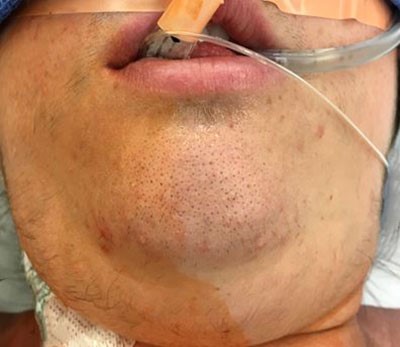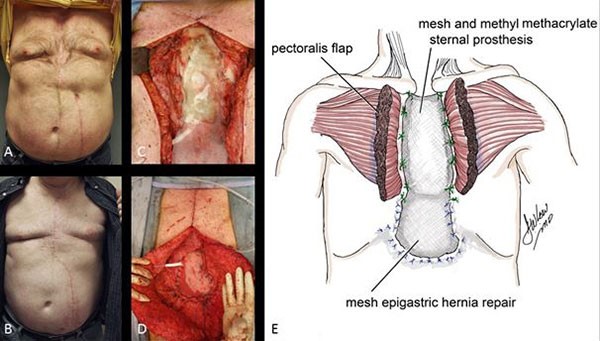Abstract
Background
Laparoscopic surgery for trauma patients has been gaining popularity as a safe and effective diagnostic and therapeutic technique, particularly for patients who present with no definite indication for laparotomy but for whom prolonged observation may be detrimental. Possibility of carbon dioxide (CO2) embolism has been proposed, but actual risk remains unknown. To our knowledge, this is the first case of CO2 embolism during laparoscopy for trauma described in literature.
Summary
We present a fifty-year-old man who sustained stab wounds to the abdomen and was hemodynamically stable the trauma bay. Focused Assessment with Sonography for Trauma (FAST) exam did not show free intraperitoneal fluid, but because of concern for fascial penetration, the patient was taken to the operating room for diagnostic laparoscopy. After insufflation and upon insertion of the first trocar, the patient developed clinical signs consistent with gas embolism. He was successfully treated with supportive measures. Laparotomy revealed multiple traumatic injuries to the bowel and mesentery as well as a contained hematoma by the inferior vena cava. Although our patient initially stabilized, and we were able to complete the damage control operation, he developed refractory acidosis, coagulopathy, and arrhythmia, and he died 12 hours after admission.
Conclusion
Patient selection is key when considering laparoscopy for trauma. Quick diagnosis and timely intervention are paramount to successful management of gas embolism.
Key Words
Carbon dioxide embolism, penetrating, trauma, laparoscopy
Introduction
Care of the trauma patient is in constant evolution. Current trends lean towards nonoperative management when clear indications for open exploration are absent. However, the question of "when to operate" continues to present a challenge as delay in diagnosis and treatment leads to poor outcomes. Minimally invasive surgery via laparoscopy offers a middle ground, reducing the possibility of missed injury and subsequent complications while sparing the cost and morbidity associated with negative laparotomy. In the 1990s, missed injury rate during diagnostic laparoscopy in trauma patients was as high as 77%.1 It has improved to 0–3% over the last decade and likely reflects increased surgeon experience and improvements in technology.2–4 One theoretical concern in trauma laparoscopy is propagation of CO2 embolism with pneumoperitoneum. This complication has been reported in other laparoscopic operations and spans gynecologic, urologic, hepatobiliary, and bariatric surgery fields.5–9 Incidence of symptomatic gas embolism during any laparoscopic case is reported to be 0.001% to 0.59%.10 It is arguably even more likely in a trauma patient due to potential existence of vascular injury or solid organ damage and presence of hypovolemia, all known risk factors for CO2 embolism. Although we do not have direct radiologic proof, we believe it occurred in our patient.
Case Description
A fifty-year-old homeless man with a history of methamphetamine abuse and diabetes was brought in after being stabbed in the left upper quadrant of the abdomen and the right shoulder. The patient was hemodynamically stable, with no evisceration or peritonitis and negative FAST exam. Decision was made to proceed to the operating room for a laparoscopic assessment of the peritoneal cavity and organs as fascial penetration was suspected. Abdomen was insufflated using Veress needle to pressure of 15 mm Hg. An umbilical trocar was inserted without issue; there was no concern for iatrogenic injury. Shortly after the anesthesiologist noted abrupt and profound drops in end-tidal CO2, blood pressure, and heart rate. Laparoscopy was aborted. Patient was placed in Trendelenburg and left lateral decubitus position; multiple doses of ephedrine, epinephrine, and phenylephrine were administered. Central venous catheter was placed in the right internal jugular vein, and an attempt was made to aspirate the gas bubble. Patient eventually stabilized enough to proceed. Midline laparotomy was performed, at which time we found four separate small bowel enterotomies, a mesenteric injury, and an injury to the inferior vena cava with a contained hematoma. Postoperatively, the patient became coagulopathic and continued to have labile blood pressure, intermittent arrhythmias, and severe acidosis. He died approximately 12 hours after admission.
Discussion
Laparoscopy is useful in trauma setting for direct visual evaluation of peritoneal cavity in patients without obvious indications for laparotomy but whose mechanism of injury leads to suspicion of intraabdominal pathology, particularly hollow viscus injuries and diaphragmatic injuries. The rate of unnecessary laparotomy has been reported at 26 to 57%,15,16 but potentially can be reduced to less than 10% by utilizing laparoscopy17,18 resulting in shorter hospital stay, fewer complications such as incisional hernia, and reduced cost.19 Appropriate patient selection remains very important, and some contraindications for laparoscopy in a trauma patient include shock, diffuse peritonitis, evisceration, penetrating anal or vaginal trauma, and intracranial trauma.
A gas embolism that causes hemodynamic instability carries 28% mortality rate.11 Given the rarity of this complication, it has only been studied in animal models that estimated that the LD50 for 70 kg person would be 1750 mL of gas.12 These studies also demonstrated that a 5 mL bubble dissolves in a pig’s right atrium in less than 30 seconds.13,14 When intraoperative gas embolism is suspected, appropriate maneuvers should be performed to allow CO2 embolus time to dissolve. Table 1 lists presenting signs and management steps.
Table 1. Gas embolism recognition and management.
| Clinical signs | Interventions |
Hypotension
Decreased cardiac output
Decreased end-tidal CO2
Hypoxia
Cyanosis
Pulmonary hypertension
Right heart strain
Jugular venous distention
Arrhythmia, ST segment changes
Myocardial infarction
Cardiac arrest | - Immediate cessation of insufflation
- Discontinuation of nitrous oxide and ventilation with 100% oxygen
- Patient should be placed in left lateral decubitus and Trendelenberg position to move the gas bubble from right ventricular (RV) outflow tract into the RV apex.
- Right internal jugular central venous catheter should be placed attempt made to aspirate gas from the RV.
- Continued fluid resuscitation
- Inotropes, vasopressors, and pulmonary vasodilators
- Cardiopulmonary resuscitation per ACLS protocol
- In extreme cases intra-aortic balloon pump or cardiopulmonary bypass may be needed.
- Hyperbaric oxygen
|
ACLS = advanced cardiac life support
Conclusion
Our experience shows gas embolism in laparoscopy for trauma is not just a theoretical possibility. The condition was recognized and addressed quickly by our anesthesiologist. Unfortunately, the combination of the intraoperative gas embolism and the patient's primary injury with subsequent coagulopathy caused his demise hours into the resuscitative efforts. Additional imaging such as computed tomography may have been helpful in identifying the vascular injury preoperatively.
Lessons Learned
To our knowledge, this is currently the only described case of carbon dioxide embolism during trauma laparoscopy in literature; therefore, we do not recommend abandoning this useful technique for fear of this rare complication. However, high index of suspicion and familiarity with the management algorithm is paramount.
Authors
Olga R Garcia, DO
Department of Surgery
Community Memorial Hospital
Ventura, CA
Joseph M Losh, DO
Department of Trauma and Critical Care
Medical College of Wisconsin
Milwaukee, WI
Barry R Sanchez, MD, FACS
Department of Surgery
Ventura County Medical Center
Ventura, CA
Javier A Romero, MD, FACS
Department of Surgery
Ventura County Medical Center
Ventura, CA
Correspondence
Dr. Olga Garcia
Department of Surgery
Community Memorial Hospital
147 N Brent Street
Ventura, CA 93003
Phone: 573-230-7805
E-mail: olga.garcia.do@icloud.com
Disclosures
The publication of this paper was funded by Community Memorial Hospital.
References
- Villavicencio RT, Aucar JA. Analysis of laparoscopy in trauma. J Am Coll Surg. 1999;189:11–20.
- Ozkan OV, Justin V, Fingerhut A, et al. Curr Trauma Rep. 2016;2:238.
- Schnüriger B, Lam L, Inaba K, et al. Negative laparotomy in trauma: are we getting better? Am Surg. 2012;78(11):1219-23.
- Kawahara NT, Alster C, Fujimura I, et al. Standard examination system for laparoscopy in penetrating abdominal trauma. J Trauma. 2009;67:589-95.
- Cottin V, Delafosse B, Viale JP. Gas embolism during laparoscopy: a report of seven cases in patients with previous abdominal surgical history. Surg Endosc. 1996;10:166-169.
- Beck DH, Mcquillan PJ. Fatal carbon dioxide embolism and severe haemorrhage during laparoscopic salpingectomy. Br J Anaesth. 1994;72(2):243-5.
- Hong JY, Kim YD. Choi KH, et al. Incidence of venous gas embolism during robotic-assisted laparoscopic radical prostatectomy is lower than that during radical retropubic prostatectomy. Br J of Anaesth. 2010;105(6):777-781.
- Aggarwal N, Gupta M, Prasad S. Near fatal carbon dioxide embolism during laparoscopy and its successful aspiration using ultrasound guided catheter. J Anesth Int Care Med. 2016;1(3):555-564.
- Zikry AA, Desousa K, Alanezi KH. Carbon dioxide embolism during laparoscopic sleeve gastrectomy. J Anaesth Clin Pharmacol. 2011;27(2):262-5.
- Mintz M. Risks and prophylaxis in laparoscopy: a survey of 100,000 cases. J Reprod Med. 1977;18:269-272.
- Park EY, Kwon JY, Kim KJ. Carbon dioxide embolism during laparoscopic surgery. Yonsei Med J. 2012;53(3):459-66.
- Graff TD, Arbegast NR, Phillips OC, et al. Gas embolism: a comparative study of air and carbon dioxide as embolic agents in the systemic venous system. Am J Obstet Gynecol. 1959;78:259-265.
- Bazin JE, Gillart T, Rasson P, et al. Haemodynamic conditions enhancing gas embolism after venous injury during laparoscopy: a study in pigs. Br J Anaesth. 1997;78(5):570-5.
- Nagao K, Reichert J, Beebe DS, Fowler JM, Belani KG. Carbon dioxide embolism during laparoscopy: effect of insufflation pressure in pigs. JSLS. 1999;3(2):91-6.
- Veekash, G, Wei LX, Su M. Carbon dioxide pneumoperitoneum, physiologic changes and anesthetic concerns. Amb Surg. 2010;16:41-46.
- Velmahos GC, Demetriades D, Toutouzas KG, et al. Selective nonoperative management in 1,856 patients with abdominal gunshot wounds: should routine laparotomy still be the standard of care? Ann Surg. 2001;234:395-402.
- Biffl WL, Kaups KL, Cothren CC, et al. Management of patients with anterior abdominal stab wounds: a Western Trauma Association multicenter trial. J Trauma. 2009;66:1294-301.
- Miles EJ, Dunn E, Howard D, Mangram A. The role laparoscopy in penetrating abdominal trauma. JSLS. 2004;8:304-309.
- Taner AS, Topgul K, Kucukel F et al. Diagnostic laparoscopy decreases the rate of unnecessary laparotomies and reduces hospital costs in trauma patients. J Laparoendosc Adv Surg Tech. 2001;11:207–11.



